Trip Report: Alternative Summer Break in Thailand

By Judith Mallory
The Tickle College of Engineering sponsored an Alternative Summer Break to Chiang Mai, Thailand, from May 17 – 26, 2019. Participating in the trip were Lauren DesJardins, Joshua Duzan, Racheal Dylewski, Jacob Fowler, Colby Gilbert, Natalie Holt, Sarah Jacob, Caleb Moon, William Prickett, and Kenton Smith, all engineering majors. TCE International Coordinator Judith Mallory led the trip, the 24th for Global Initiatives, and its second to the Asian continent. Carmen Philpot, University of Tennessee Alumna, served as co-leader.
» Read Colby Gilbert’s student trip report.
» Read Kenton Smith’s student trip report.
» Read Caleb Moon’s student trip report.
» Read Racheal Dylewski’s student trip report.
» Read Sarah Jacob’s student trip report.
» Read Josh Duzan’s student trip report.
» Read Lauren DesJardins’s student trip report.
» Read Natalie Holt’s student trip report.
Known officially as the Kingdom of Thailand and formerly as Siam, Thailand is located in the center of the Southeast Asian Indochinese Peninsula. It consists of 76 provinces of over 68 million people, and is the world’s 50th largest country by area and the 21st most populous in the world. The country is bordered by Myanmar (formerly known as Burma), Laos, Cambodia, the Gulf of Thailand, and the Andaman Sea. The coup of 2014 established a de facto military dictatorship in the country. Thailand has a high level of human development, and the second largest economy in Southeast Asia, with manufacturing, agriculture, and tourism being leading economic sectors. It is the number one exporter of jasmine rice in the world.
The monarchy of Thailand is protected by lèse-majesté, a practice originating in ancient Rome, which means “to do wrong to majesty”; it is an offense against the dignity of a reigning sovereign or against a state. Speaking in a disparaging manner against the monarchy can result in a jail term of three to fifteen years. After the 2014 coup d’état, Thailand had the highest number of lèse-majesté prisoners in the nation’s history. Since this time, the country has been rated “not free” by the Freedom House Index. Freedom in the World is a yearly report issued by the US NGO Freedom House, measuring the degree of civil liberties and political rights around the world. One may expect to see numerous photographs, some life-size, of the Royals displayed in public places all over the country.
The TCE visitors were based in Chiang Mai, located in the mountainous northern part of the country. Chiang Mai was founded in the year 1296 and served as the capital of the independent Lanna Kingdom until 1558. (The Lanna Kingdom eventually became part of Siam in 1892; Siam officially became known as Thailand in 1949.) Chiang Mai contains hundreds of elaborate Buddhist temples, and sits at 1,017 feet above sea level, with a population of 132,000. The Old City area still retains vestiges of walls and moats from its history as a cultural and religious center. Common forms of transportation around town include motor bikes and the red songthaew, which are trucks acting as shared taxis. When the covered back of the truck is full, the taxi proceeds.
The first activity of the trip was a short course on Thai language and polite customs. When greeting, thanking, or bidding good-bye to someone in Thailand, it is customary to use the wai gesture; place open hands together at chest height and bow slightly. If using the wai to a monk, the bow is deeper and the posed hands touch the center of the face. Regarding general courtesy, it is considered ill-mannered to sit with legs crossed. If you drop a coin and it is rolling away, don’t step on it to stop it, as coins bear images of Thai royalty. Bottoms of the feet are not to be seen. Shoes are to be removed before entering a home, a temple, and some businesses. Touching someone on the head is not polite, either, nor is pointing with a finger; gesturing towards something or hailing a taxi with the entire hand is acceptable. Proper temple attire was addressed as well: those visiting temples will have knees and shoulders covered; no shorts or sleeveless garments are to be worn, nor are shoes. The Thai people believe in ghosts and spirits and the concept of good luck. Some Hindu influence is mixed with the primarily Buddhist practices in Thailand. Decorum is highly valued.
After the lesson, the group made a visit to the Chiang Mai Arts and Cultural Center, a cluster of three museums, which provided an engaging and informative view of the history, culture, and life in Thailand, including the beginning of Chiang Mai, original city structure, life and practices of the various Hill Tribe people, and an interesting modern art exhibit. We learned that the city layout is in the shape of a square, imitating Cambodia’s Angkor Wat. The main building is located in an old courthouse featuring exotic wood floors and trim. The Lanna Folk life Museum section displayed elaborate textiles, cultural artifacts, altars, Buddha figurines, pottery, models of typical rooms in homes complete with appropriately dressed mannequins, musical instruments, displays of courting rituals, art, murals, and more.

After a brief rest, the next item on the agenda was the Sunday Night Market, the Tha Pae Walking Street, which is a huge and popular arts and crafts market with food and live music, opening at 5:00 p.m. each Sunday. The road is closed to vehicular traffic at this time, allowing for wide pedestrian walkway. Available for purchase in the seemingly endless booths were a variety of Thai-made goods including clothing, textiles, jewelry, pottery, preserved giant insects in display frames, art work, home décor, and more. Contained in the market is an enormous outdoor “food court,” with street vendors cooking and serving all manner of Thai food. Interestingly, we were encouraged to try all street food possible; this is usually discouraged in many other locations, but Thailand is noted for its delicious and safe-to-eat street food. One can sample a mango and rice combination, deep-fried crickets, fresh fruit drinks, pancake-on-a-stick, and jelly cartoon characters.
Another shopping experience took place later in the trip at the Thai Silk Village. Thailand is known for exquisite silk fabrics. Upon entering the establishment, one may observe the complete cycle of life of the silkworm, which begins when the moth lays the eggs, which develop into larvae; these eat for 20–30 days, consuming large quantities of mulberry leaves. After four moltings, the grub spins a cocoon of silk threads around itself for protection; in commercially viable silk, the grub is terminated at this point, when the silk is removed and spun into thread. Actual silkworms are on the premises, in order that the process can be seen in real time. Traditional vegetable dyes are used to color the thread, which is then woven on large looms into silk fabric. A show room is attached to the small interpretive center, with silk clothing for sale, as well as traditional décor items and clothing made by Hill Tribe People. A tour of a silver factory followed, with a short demonstration and a view of a shop area with bench jewelers at work.
On the third full day of the trip, the group visited the Mahachulalongkornrajavidayla University, where monks come to study. The purpose of the visit was a “Monk Chat,” an activity whereby visitors can schedule a sit-down meeting with a monk to discuss his way of life. Our monk was quite young, having came to Thailand from Myanmar, and has been at the University for three years. He is studying English, Economics, public speaking, and, of course, Buddhism. His ordination will take place in a few weeks. The notion of karma and its relation to reincarnation was briefly covered in the chat; the notion of karma is a cosmic principle whereby individuals are either punished or rewarded in one incarnation according to that individual’s deeds and behavior in a previous incarnation. Several re-birth options are available, depending upon what karma has been accumulated by the individual. Plants are less sacred than animals, which are less sacred than humans. Enlightenment is not a realistic for most people but can be achieved in this lifetime. The monk demonstrated three sitting positions for meditation, all of which require dexterity and flexibility; monks meditate to train the mind and start each academic class with a brief practice. He advised not to deny the thought that intrudes during meditation, but rather to acknowledge it and move on. Meditation can take place while seated or walking. He led the group in a short walking meditation and gave tips for meditating successfully; concentration meditation is said to bring joy. He briefly discussed Buddhism and his daily routine but was far more interested in the United States and the TCE visitors. Novices, of which he is considered, adhere to ten precepts for Buddhism, including abstaining from lying, killing, stealing, sensual misconduct, over eating, dancing, intoxication, and the use of luxurious beds. An important aspect of Buddhism is preaching the dharma to young people; this is the nature of reality regarded as a universal truth taught by the Buddha. He lamented that young people are not interested and do not want to listen.
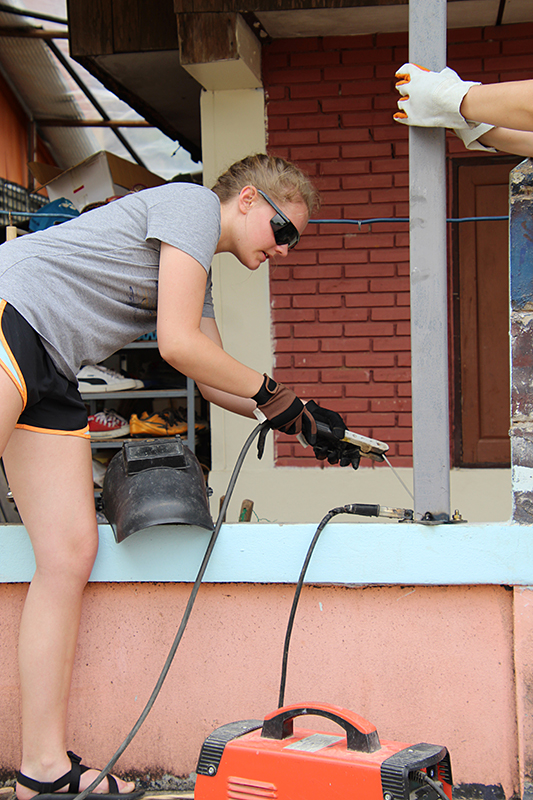
That afternoon, the group went to the service project site for the first time. A home for 25 children, the word “orphanage” appears on the establishment’s sign; however, the children are not orphans in the true sense of the word. The children live at the home with two parent figures, a husband and wife who take care of them and operate the home. The children are from Hill Tribe People of Thailand, who do not have access to schools in their remote communities. Not indigenous Thai, the Hill Tribes are immigrants from nearby Viet Nam and Cambodia, who fled their countries during warring times for a safer place to live. They have no written language. The children live in the Home, right outside of Chiang Mai, and visit their parents on holidays. They attend a local school during the day, picked up and dropped off by a school bus, just as children are in the US.
For security as well as aesthetic reasons, a new fence was needed along one side of the children’s home, which is along a street. This was the project that the TCE students would undertake over several visits. First, rusty barbed wire, rotten fence slats, and old fence supports had to be removed. New, heavy metal supports were welded in place in an upright direction, before horizontal pieces were attached, all to serve as a brace for the fence sections. The engineers undertook the project entirely from start to finish, including formulating the best way to construct the fence and the division of labor. They cut individual slats from a material similar to a medium density fiberboard (MDF), denser than plywood. The fence was approximately seven feet in height at its highest point and spanned about 100 feet. Upon completion, it was painted a bright green color.
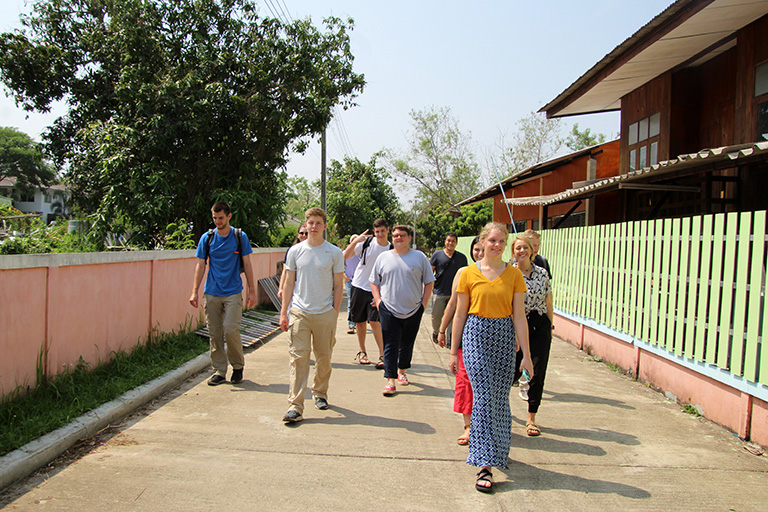
The main activity on day four of the trip was a visit to the magnificent Wat Phra That Doi Suthep, a Theravada Buddhist temple and one of the more elaborate ones in the country as well as the oldest in Thailand. The temple’s name actually describes what will be found therein: Phra indicates an honorific Buddha image, That indicates a relic; combining the two terms indicates that the Wat contains a relic of Buddha’s. Doi Suthep is the name of the mountain atop which the temple sits.
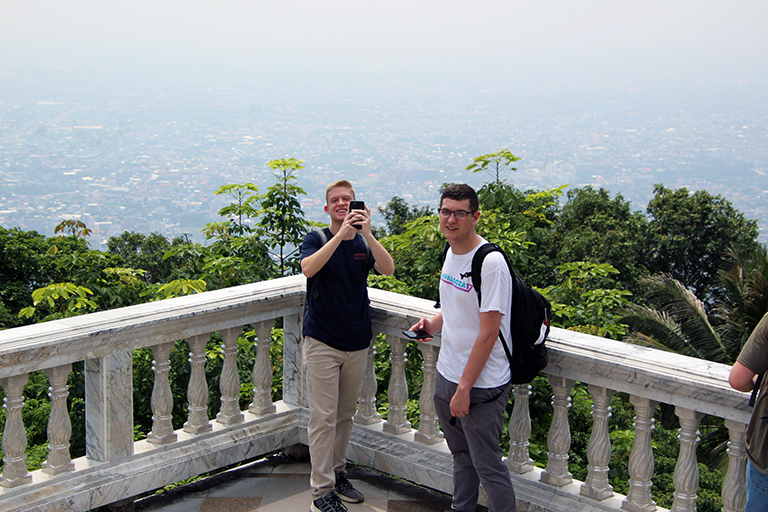
The main focus of Theravada Buddhism is to rid the self of unwholesomeness, focusing on peace, lightness, and floating. According to legend, in the year 1368, a monk was led by a vision to find what was purportedly the shoulder bone of Buddha himself. The relic displayed magical powers. He took it to one of the kings, for whom it failed to display anything remarkable, and the monk was told to keep it. The king of Lanna heard tales of the bone and summoned the monk to bring it to him. Once he arrived, the bone broke in two. The smaller piece is at Wat Suan Dok in its own shrine. The king placed the other piece on the back of a white elephant, an animal sacred to the Thai people, which went into the jungle and then climbed up Doi Suthep where it trumpeted three times, before dropping dead. Interpreting this as an omen, the king ordered the construction of a temple at the site. Naturally, the site includes a white elephant shrine.
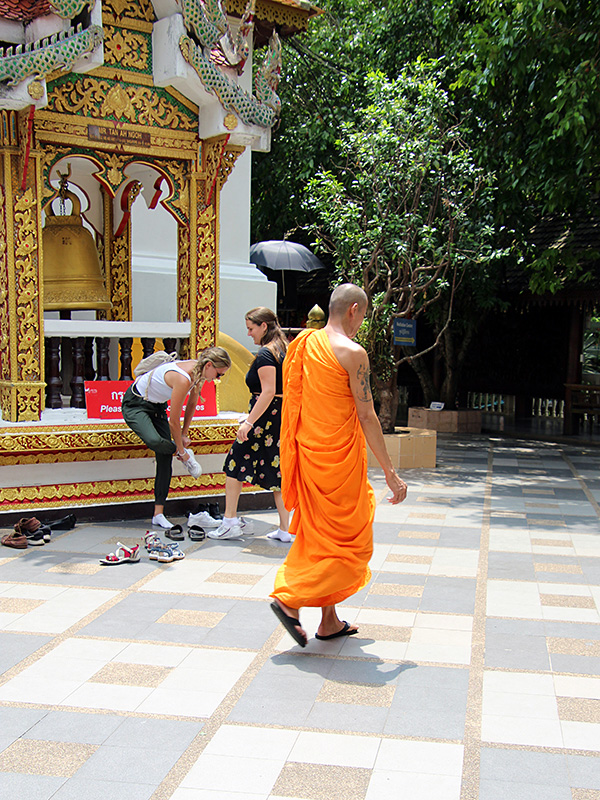
Viewed as a sacred site by many Thai people, it is accessed by 309 bejeweled Naga-lined steps, the longest Naga balustrade, or serpent banister, in all of Thailand. Naga is the name for the mythical many-hooded serpent, revered by the Buddhists as protectors. Legend has it that a Naga protected Buddha during a storm in which he was meditating. Many individual Buddha statues of various styles and materials are at the site, donated from the faithful around the world. The central feature of the Wat is a 79’ tall gold-plated stupa, or chedi, a symbol of the Buddha’s enlightened mind and presence; it imitates the seated Buddha in its shape, with the spire representing enlightenment, the zenith of Buddhist attainment. Structures and shrines on the site point inwards to the stupa, indicating its significance to the Wat. Tradition calls visitors to participate in a ritual, whereby one silently walks around the stupa in a clockwise direction, holding a flower. At the conclusion of the third rotation, the flower is placed in a bath of water, as an offering to the gods. The final piece of the ritual is to light a small candle and make a wish. Another part of the temple offers a form of “fortune telling.” The participant takes a cylindrical container of sticks, open on one end, kneels on the floor, and shakes the container until one stick emerges further out than the others. On the stick is a number, corresponding to numbered fortunes foretold on paper and available in a rack on the wall nearby. All of the visitors in the TCE group were purportedly in for bad luck. Hand painted murals tell the story of Buddha’s life and include Hindu aspects as well. Considered a sacred pilgrimage site due to its history and the presence of the relic, the Wat can get as many as 120,000 visitors per month. On Visakha Bucha Day, local people climb the mountain and sleep on the esplanade to celebrate the birth, enlightenment, and death of the Buddha. A terrace at the temple site affords commanding views of Chiang Mai.
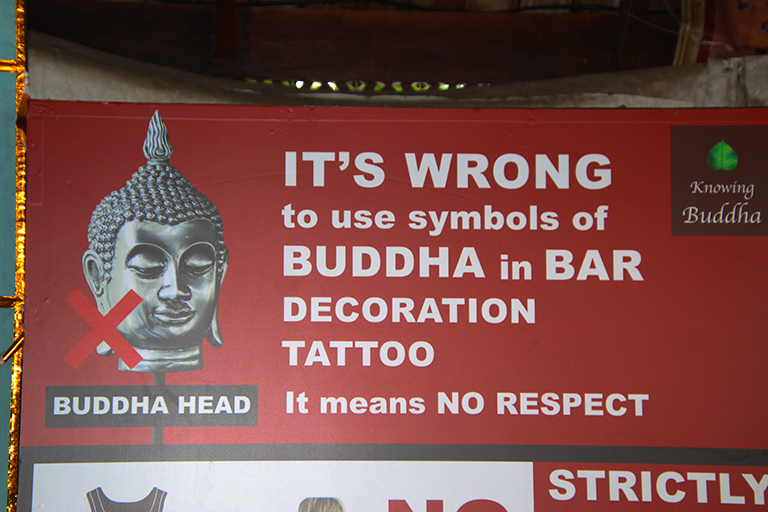
Several signs are posted reminding visitors to dress appropriately, not stand on Buddha statues, not get a Buddha tattoo or use him in advertisements for drinking establishments, and so forth.
The group visited a much smaller and less elaborate temple in town, to observe how architectural renovations are underway on the hundred-year-old structure. After that, they made a quick visit to another small temple nearby, to present a gift of food to the monks there. Monks live a life of poverty as a sign of devotion to the Buddha; therefore, everything they possess and consume must come to them as a gift. Presenting them with food is not considered an act of charity, but rather as an exchange, as the monk’s gift back to the layperson comes in the form of prayers and teachings.
A common sight around Chiang Mai and surrounding areas are Spirit Houses. These are most often located in the front of a business or in the front yard of a house. The small street behind the orphanage had one of a bit larger scale, and was probably for several houses to share. The Spirit House acts as a shrine to the protective spirit of a particular place, and is apparently commonplace in Southeast Asian countries. Normally, it is in the form of a small roofed structure, mounted on a pillar or platform. They may contain statues of people or animals, and range in size from that of a birdhouse, to a house large enough in which people may fit inside. Their purpose is to provide a shelter for spirits, which might cause problems for the people in the actual house, if the spirits are not appeased. One may leave votive offerings to propitiate the spirits. Interestingly, it serves essentially the same purpose as bottle trees seen throughout Appalachia.
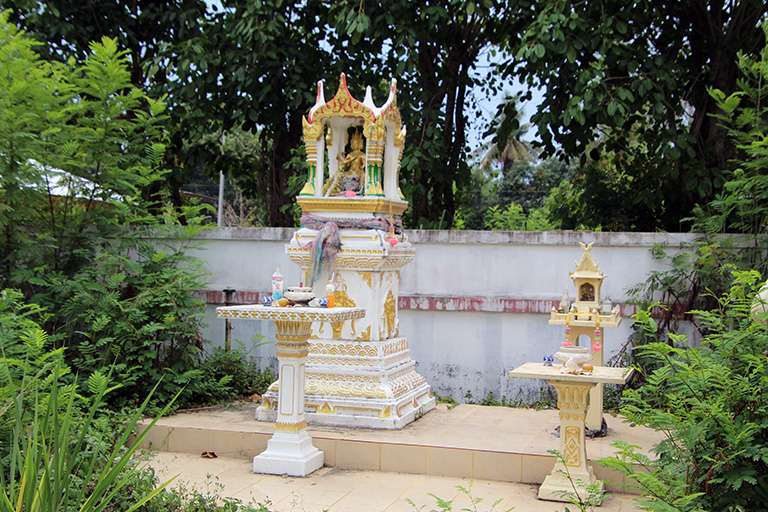
One of the highlights of the trip was a visit to the Thai Elephant Home. Established in 2006 with one elephant, the Home has since grown, tending to and caring for a population of twenty elephants. The primary goal is conservation and preservation of the endangered majestic Asian elephant. Adult elephants have been rescued from unhealthy working conditions and brought here to perpetuate the species and simply enjoy life. The Home is also involved in jungle reforestation, land purchase, local job creation, and educational scholarships for disadvantaged Hill Tribe youth. The land purchase goal of the Home is to expand the elephants’ natural habitat and protect it. Each elephant has its own mahout, or caregiver. The Elephant Home has an active breeding program. In the area of the property where visit took place, there are three adult females. The one most recently arriving at the home was working in logging in Myanmar; logging has long been illegal in Thailand. She and another female both have babies, and the third female acts as an “Aunt” to the little ones, often promoting their mischief. Our host, Mr. T, is a retired American schoolteacher from Minnesota, and former Peace Corps volunteer. He explained how the elephants came to live at the home, and how they interact with each other and the baby elephants. The visit began with a short introduction; everyone was given matching, two-piece mahout outfits into which to change, in order that they could leave wearing clean clothing. The first item on the agenda was to meet the elephants and feed them bananas. The adults could devour an entire stalk of bananas in short order. Then, the adult and baby elephants were taken for a walk through the forest. This was at a leisurely pace, as the animals would stop to eat vegetation along the way. The trail formed a loop which arrived back at the campsite. The group was then treated to a traditional lunch of pad thai, a stir-fried rice noodle dish, served on a fresh banana leaf. After lunch and a short rest, the guests were invited into a large pond with the elephants to wash them. To conclude this process, the elephants walked over to a dry area, to spread dirt all over themselves. Mr. T explained that this is beneficial and protective of their skin; it was similar to humans using powder after a bath.
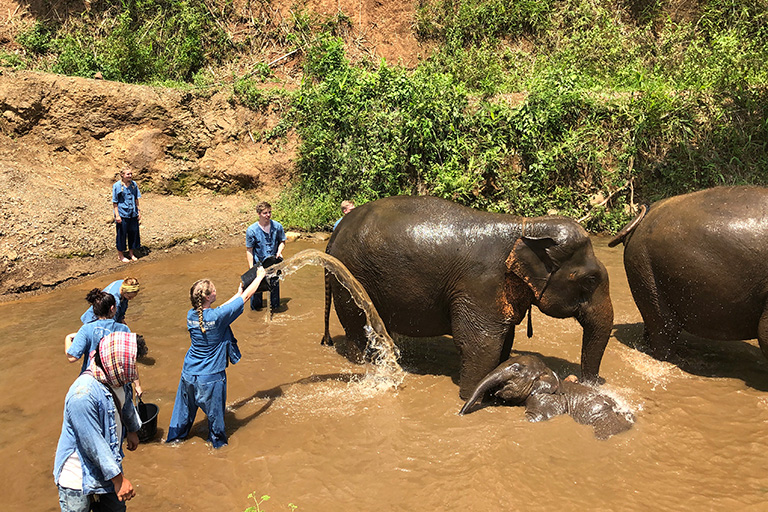
The cooking class began by meeting our instructor, Nam, at the Mae Hia Fresh Market, a huge outdoor market of fruits, vegetables, spices, herbs, fresh meat, and even live fish. Nam identified and talked about items one would usually find in Thai cooking, including tiny eggplants, lemongrass, ginger root, and scallions. She went to several stalls, picking up items as she described the taste and use of each one. From there, it was about a ten-minute walk to the Smart Cook Thai Cookery School. Nam briefly explained culinary traditions. Normally, spoons are used to consume food; forks are used only to push food onto the spoon. Chopsticks are only used to eat noodle dishes. Everyone was given an apron and their own work station, complete with knife, cutting board, gas burner, pot, and wok. We were led through complete instructions and were able to cook Chicken in Coconut Milk Soup, Pad Thai, Curry Paste, and Sticky Rice Pudding. After cooking the food, the bonus was getting to eat it.
The final activity on the itinerary was a small cruise on the Ping River, known there as the Thai Mae Nam Ping, with dinner served on board. The next day was free for the visitors to sightsee and prepare for the long trip home to start the summer semester.